After 'The Storybook Wolf' was so publicly discredited, what does it mean for wildlife photography?
After the Natural History Museum confirmed the image ‘The Storybook Wolf‘ was being disqualified after an internal investigation, the photographer José Luis Rodríguez has ‘strongly denied’ the accusations that the animal was a tame, trained actor. Lengthy investigations by the Wildlife Photography department of the museum as well as advice from trained professionals and via questioning of the photographer has resulted in the removal.
According to the rules of the 2010 competition ‘Pictures of animal models or any other animals being exploited for profit may not be entered.’ making it absolutely clear that, in the case of Mr Rodríguez’s image, there would be no room for argument.
Acclaimed photographer Andy Rouse, in an interview with Amateur Photographer (which can be found here), explained ‘To get this close, to get the lighting so perfect and the timing so exquisite was just incredible and I was slightly in awe of the photographer.’ Taking such an elusive subject in nigh-on perfect lighting and in motion while maintaining a stunning level of sharpness and contrast raised the question of whether the animal was trained, or baited. In following a set path the photographer could place the setup in an agreed area, then simply wait for the animal to pass. In his original statement relating to the image Mr Rodríguez stated “I wanted to capture a photo in which you would see a wolf in an act of hunting – or predation – but without blood,” he told BBC News. “I didn’t want a cruel image.” which indicates how much consideration had gone into the form and content of the shot. By no means is this a damning indication of the photographer’s guilt, but it certainly shows how much thought had predated the photo being taken.
Amateur Photographer forum member Huw Evans seems to perfectly capture the mood of a number of photographers by stating ‘For myself, I do recall feeling a distinct sense of unease when I first saw the picture – but that had nothing to do with whether the wolf was captive or not. As a matter of fact I didn’t even know this competition made such a distinction until this story surfaced. Rather, my unease was just a personal frustration with the fact that so often these great wildlife shots evidently take weeks or even months of careful planning and preparation, and would be well-nigh impossible for most of us mere mortals to achieve. I’m much more comfortable when I see great shots that practically anyone could have taken, with a reasonable amount of effort and skill.’
Many of us have been continually frustrated by our efforts to capture subjects that rarely follow a set path or become close enough to shoot a decent image, so the fact that ‘The Storybook Wolf’ has been so publicly discredited creates a number of questions over the validity of numerous images. Baiting and utilizing tame animals is by no means a new practice in wildlife photography, nor is it likely to end anytime soon. But the likelihood is any image deemed ‘too good’ could easily face the same scrutiny, whether entered into a competition or not.
I, for one, was mesmerized by the image, not purely from a technical standpoint but also due to the obvious effort the photographer had taken to create such a perfect result. Each viewing now conjures up an almost film set-like setting, with trailers and a far off voice shouting ‘action’ rather than a dedicated photographer in the field battling the elements. Perhaps this is exaggerated by the swirl of controversy and an amount of my own envy, but wildlife photography will certainly need to take note and respond to prevent further questions being raised.





